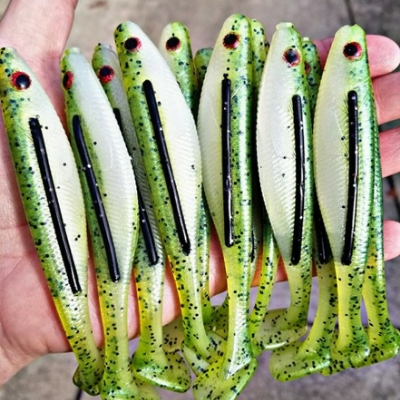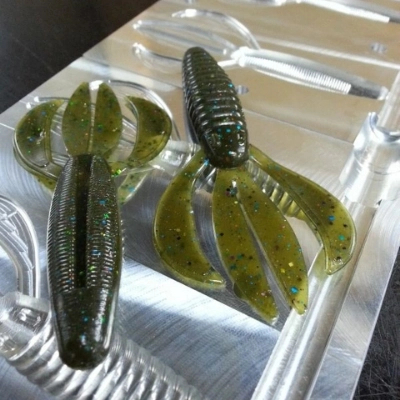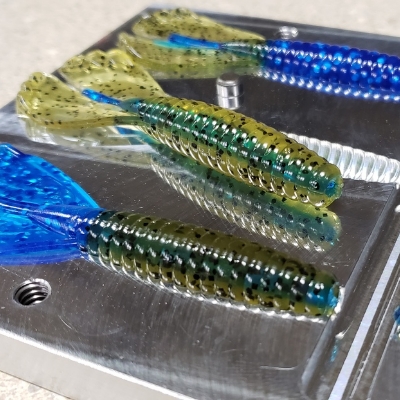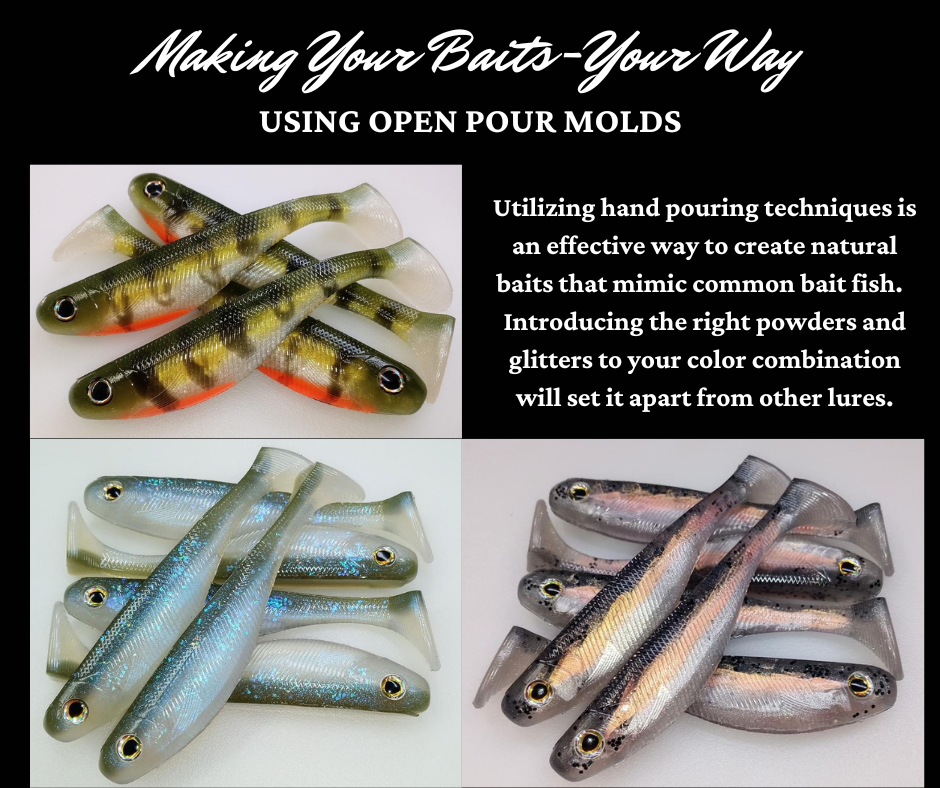Making Soft Plastic Baits-Make Your Own Unique Bait
By Angling Ai on 13th Dec 2022

Making Soft Plastic Baits —Make Your Own Unique Bait
Creating soft plastic baits has grown in popularity in the last few years. People of all ages participate in the wonderful addition to the fishing industry. Involvement as a hobbyist dominates the craft, but some have started their own soft plastic bait businesses. What has led people to this intriguing new world of fishing? Well, several things:
- Empty shelves as the industry became swamped with an influx of new Anglers across the world.
- Major manufacturers canceled some designs or color patterns of lures that fishermen were highly attached to.
- Internet how-to videos from the likes of ‘Worlds Worst Fishing’ and others gained subscribers and an interest developed from the public for creating their own soft plastics.
While all these reasons are valid, one thing is for sure, catching a fish on a bait you created is exhilarating over and over again. That lure alone has brought attention to making your own unique baits.
Starting Your Unique Bait Creation
Beginning to create your own baits can seem overwhelming at first. Using soft plastic to produce your own fishing lures is actually a simple process. A few necessary items need to be acquired to start.
- A heating source, usually a 700-watt microwave
- Gloves that will protect your hands from the 350℉ or hotter plastic
- Eye protection
- A thermometer to measure your plastic temp
- Pyrex-type measuring cups
- Small measuring spoons
- Something to stir hot plastic with
- And, of course, the soft plastic bait-making materials.
Selecting Your Bait-Making Materials
Proper material selection will be based on your personal preferences, but in general, you will need to consider what type of mold you want to use.
- Do you want to use an open pour or injection mold?
- Are you looking for a core shot style mold?
- What type of fishing will you be doing, finesse, power, or utilizing a creature for flipping, pitching, or punching?
CNC-designed aluminum bait molds, like Angling Ai offers, provide bait makers with the highest quality finish for their soft plastic fishing lures.
Choosing your desired plastisol will also be important to your finished product. How much movement and durability do you want your bait to have? Achieving the presentation attributes your lure has depends on the durometer. A higher durometer plastic is stiffer. Saltwater plastisols have a high durometer; as you scale down to Firm, Craw Tube, or Soft, Worm-type blends, the durometer is lower. Finding that plastic that matches your presentation preference is key to making your bait unique.
Another factor in plastisol is floating or sinking plastic. Naturally making soft plastic frogs, shaky heads, and drop shots floating plastisol would be preferred. If you are making Swimbaits floating or sinking plastisol? Deciding that comes down to how you want to present that bait. Making your own soft plastic fishing baits really allows you to be unique in your design.
Materials That Scream Unique
Glitters, colorants, powders, and other additives are what make a bait become distinctive. Yes, the appearance of the soft plastic fishing lure can be unique. When making your own, however, you develop the knowledge of how these materials can create one-of-a-kind lures.
All That Glitters?
Glitters are now coming out in so many different shapes, sizes, and colors. A lure maker can add .04 glitter to their baits or create depth in their transparent color by using different sizes of glitter during production up to .62. Color can be changed in tone or hue just by the glitter combination you come up with. Will you use square-shaped, hexagonal, or whisker glitter? How many different colors will you use, and will it be just a little blue with more red and black or holographic glitter? Smaller glitters will almost look like colorant when taking a closer look. Developing new glitter combinations for your lures is endless! Controlling the amount of glitter added to your plastisol mix is a characteristic bait makers love to control.
Color Color Color
Picking the base color of your lure can be achieved in many different ways. You can mix colors together or pick an already-known base color. Colorants can be transparent, opaque, or even changeable. If your material list includes a dual injector, laminate-style baits can be made. If you’re looking for a camo or swirled look for your design, an Angling Ai ‘C’ block would be required.
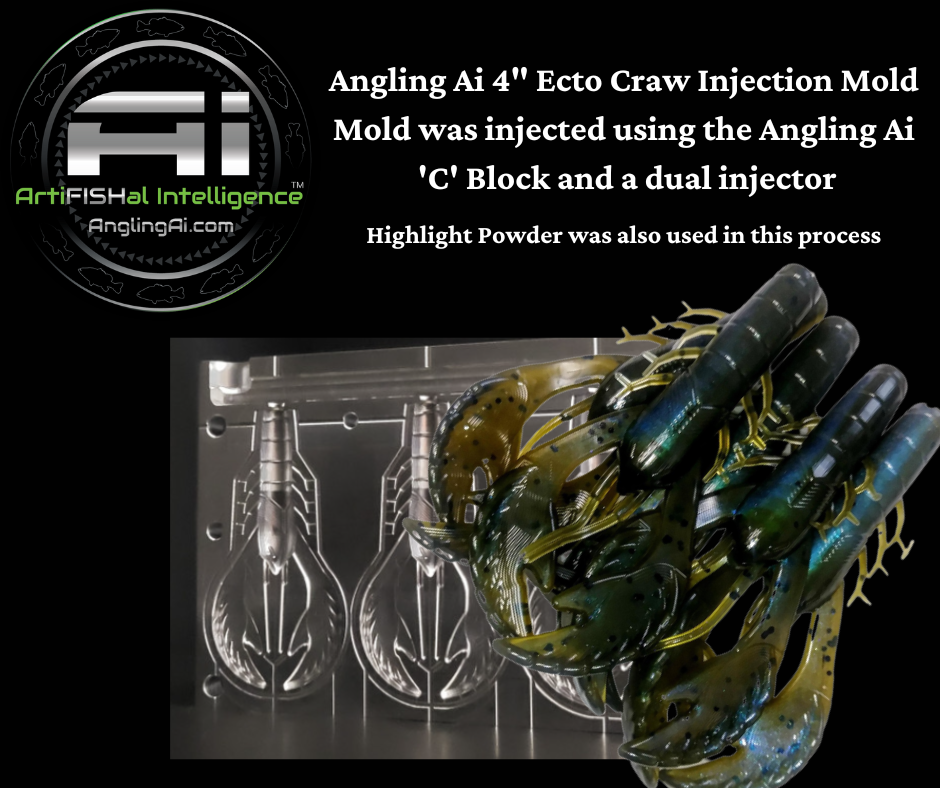
Non-bleed and Bleeding colorants are one very important aspect of color for bait makers to be aware of. Colorants that bleed are typically made with dyes, while non-bleed colorants are usually pigment-based. Creating lures with colorants that bleed is not uncommon, but the color will bleed into other colors and affect the appearance of the bait eventually. Bait makers never need to worry about their creations if they use non-bleed colorants. Mixing colorants together can create your own special blend of color. Bait makers love to add their own twist to common colors. Green Pumpkin, Junebug, and Watermelon are colors that often have several versions and looks. The power of developing that special version of color for a soft plastic lure is yours.
The Power of Powders
Powders come in highlights, pearls, micas, color shifts, glows, and UV. Small amounts of these additives can go a very long way. Learning how to harness the special effects created with powders will unlock the imagination and artistic ability of your bait-making. Here are some of the things we’ve learned:
- Color shift powders will require some trial and error to establish which ones are useful in plastic. Different amounts of color shift powder can either add or take away from their intended effect.
- Mica powders are very similar in use to the color shift. Opaque and transparent effects can be created using mica powders, and when used with white or black colorants, both have more of an intense effect.
- Glow and UV powders are simple, and just add them to your plastisol mix to produce glowing lures or to add a little UV effect to your bait in the water.
- Rich, opaque-looking colors are created with pearl powder if used in higher amounts. A little bit will affect the bait some with a little sheen and the color will be pretty consistent throughout.
- Highlight powders will produce an iridescent effect. When using highlights it will create a special flash of color when the light reflects off of the lure from different angles. The effect stays on the outside of the lure and produces some very natural looks you find in nature.
Producing Your Special Lure
Being able to decide all the aspects of your soft plastic bait makes it distinctive. A basic lure can be special just by the plastisol used to produce it. Mold selection is critical. In a previous blog we discussed mold material and how it affects the aesthetics of the finished product, “Why Great Fishing Lure Molds Matter”. Ifyou are looking to create a pattern-filled bait you will need an Open-Pour Mold.
Open-pour molds are tougher to pour and require practice. The world of bait-making does unfold with the use of an open-pour mold. Popular open-pour swimbait molds and worm molds are also available at Angling Ai. Injection mold techniques are limited but the techniques that can be applied to open-pour designs are vast. Learning how to apply the techniques to an open pour allows bait makers to create baits that are extremely artistic and realistic.
When selecting your mold also consider how many different ways you can implement the design to your fishing styles. Angling Ai Ecto Craw is an injection mold that can be fished in many ways. Selecting the right plastisol to match the style of fishing you will choose can assist in making it perform better. Now the rest of your special bait design is in its appearance. Colorants, Glitter, Highlights, Pearls, etc., can set your bait apart from others, and the wonderful world of bait-making will set you apart from others. You have the power to create and be different. Fishing is always a special time, that is why we love it. Choose to ‘Make Your Baits-Your Way’ and ‘Put That On A Hook’!
